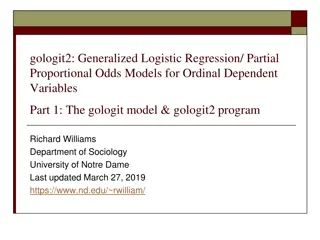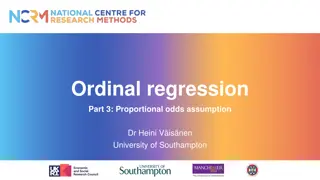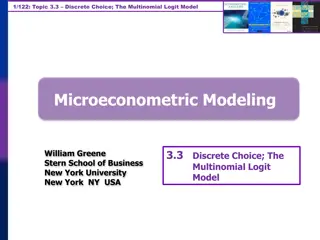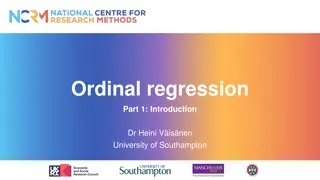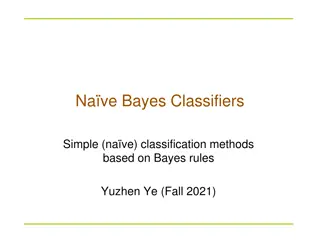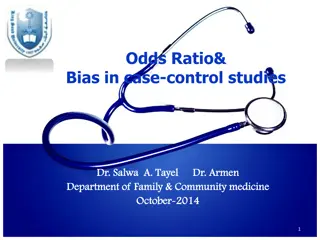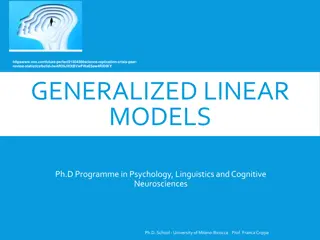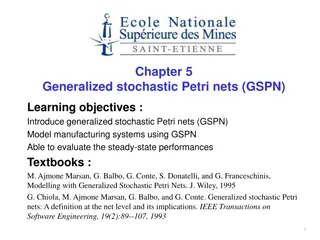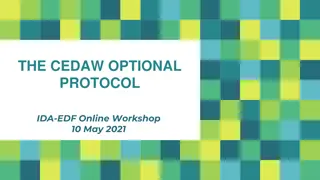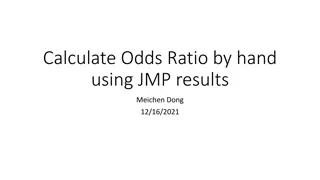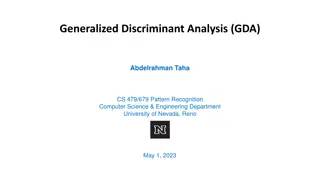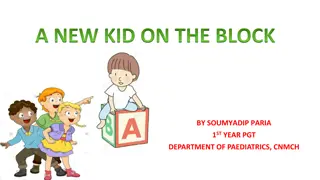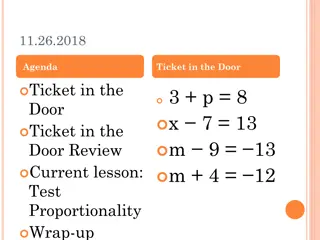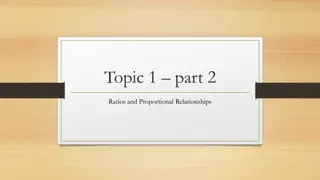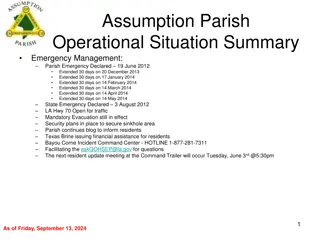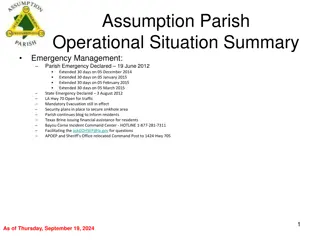Understanding Violations of Proportional Odds Assumption in Generalized Ordered Logit Models
The article discusses violations of the proportional odds assumption in generalized ordered logit models. It provides examples of when assumptions are not violated and when they are partially violated, illustrating how gender impacts attitudes. Model illustrations and analysis showcase the implications of such violations on model interpretation and statistical outcomes.
Uploaded on Oct 05, 2024 | 0 Views
Download Presentation

Please find below an Image/Link to download the presentation.
The content on the website is provided AS IS for your information and personal use only. It may not be sold, licensed, or shared on other websites without obtaining consent from the author. Download presentation by click this link. If you encounter any issues during the download, it is possible that the publisher has removed the file from their server.
E N D
Presentation Transcript
Generalized Ordered Logit Models Part II: Interpretation Richard Williams University of Notre Dame, Department of Sociology rwilliam@ND.Edu Updated March 27, 2019 https://www.nd.edu/~rwilliam/
Violations of Assumptions We previously talked about violations of the parallel lines/ proportional odds assumption. Parallel lines isn t too hard to understand but what does proportional odds mean? Here are some hypothetical examples
Example of when assumptions are not violated Model 0: Perfect Proportional Odds/ Parallel Lines | attitude gender | SD D A SA | Total -----------+--------------------------------------------+---------- Male | 250 250 250 250 | 1,000 Female | 100 150 250 500 | 1,000 -----------+--------------------------------------------+---------- Total | 350 400 500 750 | 2,000 1 versus 2, 3, 4 OddsM 750/250 = 3 OddsF 900/100 = 9 OR (OddsF / OddsM) 9/3 = 3 Gologit2 Betas 1.098612 Gologit2 2 (3 d.f.) 176.63 (p = 0.0000) Ologit 2 (1 d.f.) 176.63 ( p = 0.0000) Ologit Beta (OR) 1.098612 (3.00) Brant Test (2 d.f.) 0.0 (p = 1.000) Comment If proportional odds holds, then the odds ratios should be the same for each of the ordered dichotomizations of the dependent variable. Proportional Odds works perfectly in this model, as the odds ratios are all 3. Also, the Betas are all the same, as they should be. 1 & 2 versus 3 & 4 500/500 = 1 750/250 = 3 3/1 = 3 1.098612 1, 2, 3 versus 4 250/750 = 1/3 500/500 = 1 1/ (1/3) = 3 1.098612
Examples of how assumptions can be violated Model 1: Partial Proportional Odds I | attitude gender | SD D A SA | Total -----------+--------------------------------------------+---------- Male | 250 250 250 250 | 1,000 Female | 100 300 300 300 | 1,000 -----------+--------------------------------------------+---------- Total | 350 550 550 550 | 2,000 1 versus 2, 3, 4 OddsM 750/250 = 3 OddsF 900/100 = 9 OR (OddsF / OddsM) 9/3 = 3 Gologit2 Betas 1.098612 Gologit2 2 (3 d.f.) 80.07 (p = 0.0000) Ologit 2 (1 d.f.) 36.44 (p = 0.0000) Ologit Beta (OR) .4869136 (1.627286) Brant Test (2 d.f.) 40.29 (p = 0.000) Comment Gender has its greatest effect at the lowest levels of attitudes, i.e. women are much less likely to strongly disagree than men are, but other differences are smaller. The effect of gender is consistently positive, i.e. the differences involve magnitude, not sign. 1 & 2 versus 3 & 4 500/500 = 1 600/400 = 1.5 1.5/1 = 1.5 .4054651 1, 2, 3 versus 4 250/750 = 1/3 300/700 = 3/7 (3/7)/(1/3) = 1.28 .2513144
Examples of how assumptions can be violated Model 2: Partial Proportional Odds II | attitude gender | SD D A SA | Total -----------+--------------------------------------------+---------- Male | 250 250 250 250 | 1,000 Female | 100 400 250 250 | 1,000 -----------+--------------------------------------------+---------- Total | 350 650 500 500 | 2,000 1 versus 2, 3, 4 OddsM 750/250 = 3 OddsF 900/100 = 9 OR (OddsF / OddsM) 9/3 = 3 Gologit2 Betas 1.098612 Gologit2 2 (3 d.f.) 101.34 (p = 0.0000) Ologit 2 (1 d.f.) 9.13 (p = 0.0025) Ologit Beta (OR) .243576 (1.275803) Brant Test (2 d.f.) 83.05 (p = 0.000) Comment Gender has its greatest and only effect at the lowest levels of attitudes, i.e. women are much less likely to strongly disagree than men are. But, this occurs entirely because they are much more likely to disagree rather than strongly disagree. Other than that, there is no gender effect; men and women are equally likely to agree and to strongly agree. The ologit estimate underestimates the effect of gender on the lower levels of attitudes and overestimates its effect at the higher levels. 1 & 2 versus 3 & 4 500/500 = 1 500/500 = 1 1/1 = 1 0 1, 2 3 versus 4 250/750 = 1/3 250/750 = 1/3 (1/3)/(1/3) = 1 0
Examples of how assumptions can be violated Model 3: Partial Proportional Odds III | attitude gender | SD D A SA | Total -----------+--------------------------------------------+---------- Male | 250 250 250 250 | 1,000 Female | 100 400 400 100 | 1,000 -----------+--------------------------------------------+---------- Total | 350 650 650 350 | 2,000 1 versus 2, 3, 4 OddsM 750/250 = 3 OddsF 900/100 = 9 OR (OddsF / OddsM) 9/3 = 3 Gologit2 Betas 1.098612 Gologit2 2 (3 d.f.) 202.69 (p = 0.0000) Ologit 2 (1 d.f.) 0.00 (p = 1.0000) Ologit Beta (OR) 0 (1.00)) Brant Test (2 d.f.) 179.71 (p = 0.000) Comment The effect of gender varies in both sign and magnitude across the range of attitudes. Basically, women tend to take less extreme attitudes in either direction. They are less likely to strongly disagree than are men, but they are also less likely to strongly agree. The ologit results imply gender has no effect while the gologit results say the effect of gender is highly significant. Perhaps the current coding of attitudes is not ordinal with respect to gender, e.g. coding by intensity of attitudes rather than direction may be more appropriate. Or, suppose that, instead of attitudes, the categories represented a set of ordered hurdles, e.g. achievement levels. Women as a whole may be more likely than men to clear the lowest hurdles but less likely to clear the highest ones. If men are more variable than women, they will have more outlying cases in both directions. Use of ologit in this case would be highly misleading. 1 & 2 versus 3 & 4 500/500 = 1 500/500 = 1 1/1 = 1 0 1, 2, 3 versus 4 250/750 = 1/3 100/900 = 1/9 (1/9)/(1/3) = 1/3 -1.098612
Every one of the above models represents a reasonable relationship involving an ordinal variable; but only the proportional odds model does not violate the assumptions of the ordered logit model FURTHER, there could be a dozen variables in a model, 11 of which meet the proportional odds assumption and only one of which does not We therefore want a more flexible and parsimonious model that can deal with situations like the above
Unconstrained gologit model Unconstrained gologit results are very similar to what we get with the series of binary logistic regressions and can be interpreted the same way. The gologit model can be written as + exp( + ) X = j i X j = ( ) j , , 1 2, ..., M 1 P Y j i + 1 [exp( )] j i j
The ologit model is a special case of the gologit model, where the betas are the same for each j (NOTE: ologit actually reports cut points, which equal the negatives of the alphas used here) + i X exp( + ) i X = j = ( ) j , , 1 2, ..., M 1 P Y j i + 1 [exp( )] j
Partial Proportional Odds Model A key enhancement of gologit2 is that it allows some of the beta coefficients to be the same for all values of j, while others can differ. i.e. it can estimate partial proportional odds models. For example, in the following the betas for X1 and X2 are constrained but the betas for X3 are not. + + + exp( + 1 X 1 2 X 2 3 X 3 ) X X X j i i i j = = ( ) j , , 1 2, ..., M 1 P Y j i + + + 1 [exp( 1 1 2 2 3 3 )] j i i i j
Either mlogit or unconstrained gologit can be overkill both generate many more parameters than ologit does. All variables are freed from the proportional odds constraint, even though the assumption may only be violated by one or a few of them gologit2, with the autofit option, will only relax the parallel lines constraint for those variables where it is violated
Generalized Ordered Logit Estimates Number of obs = 2293 LR chi2(10) = 338.30 Prob > chi2 = 0.0000 Log likelihood = -2826.6182 Pseudo R2 = 0.0565 ( 1) [1SD]white - [2D]white = 0 ( 2) [1SD]ed - [2D]ed = 0 ( 3) [1SD]prst - [2D]prst = 0 ( 4) [1SD]age - [2D]age = 0 ( 5) [2D]white - [3A]white = 0 ( 6) [2D]ed - [3A]ed = 0 ( 7) [2D]prst - [3A]prst = 0 ( 8) [2D]age - [3A]age = 0 ------------------------------------------------------------------------------ warm | Coef. Std. Err. z P>|z| [95% Conf. Interval] -------------+---------------------------------------------------------------- 1SD | yr89 | .98368 .1530091 6.43 0.000 .6837876 1.283572 male | -.3328209 .1275129 -2.61 0.009 -.5827417 -.0829002 white | -.3832583 .1184635 -3.24 0.001 -.6154424 -.1510742 age | -.0216325 .0024751 -8.74 0.000 -.0264835 -.0167814 ed | .0670703 .0161311 4.16 0.000 .0354539 .0986866 prst | .0059146 .0033158 1.78 0.074 -.0005843 .0124135 _cons | 2.12173 .2467146 8.60 0.000 1.638178 2.605282 -------------+---------------------------------------------------------------- 2D | yr89 | .534369 .0913937 5.85 0.000 .3552406 .7134974 male | -.6932772 .0885898 -7.83 0.000 -.8669099 -.5196444 white | -.3832583 .1184635 -3.24 0.001 -.6154424 -.1510742 age | -.0216325 .0024751 -8.74 0.000 -.0264835 -.0167814 ed | .0670703 .0161311 4.16 0.000 .0354539 .0986866 prst | .0059146 .0033158 1.78 0.074 -.0005843 .0124135 _cons | .6021625 .2358361 2.55 0.011 .1399323 1.064393 -------------+---------------------------------------------------------------- 3A | yr89 | .3258098 .1125481 2.89 0.004 .1052197 .5464 male | -1.097615 .1214597 -9.04 0.000 -1.335671 -.8595579 white | -.3832583 .1184635 -3.24 0.001 -.6154424 -.1510742 age | -.0216325 .0024751 -8.74 0.000 -.0264835 -.0167814 ed | .0670703 .0161311 4.16 0.000 .0354539 .0986866 prst | .0059146 .0033158 1.78 0.074 -.0005843 .0124135 _cons | -1.048137 .2393568 -4.38 0.000 -1.517268 -.5790061 ------------------------------------------------------------------------------
Interpretation Once we have the results though, how do we interpret them??? There are several possibilities.
Interpretation 1: gologit as non-linear probability model As Long & Freese (2006, p. 187) point out The ordinal regression model can also be developed as a nonlinear probability model without appealing to the idea of a latent variable. Ergo, the simplest thing may just be to interpret gologit as a non-linear probability model that lets you estimate the determinants & probability of each outcome occurring. Forget about the idea of a y* Other interpretations, such as we have just discussed, can preserve or modify the idea of an underlying y*
Interpretation 2: The effect of x on y depends on the value of y Our earlier proportional odds examples show how this could plausibly be true Hedeker and Mermelstein (1998) also raise the idea that the categories of the DV may represent stages, e.g. pre-contemplation, contemplation, and action. An intervention might be effective in moving people from pre- contemplation to contemplation, but be ineffective in moving people from contemplation to action. If so, the effects of an explanatory variable will not be the same across the K-1 cumulative logits of the model
Working mothers example Effects of the constrained variables (white, age, ed, prst) can be interpreted pretty much the same as they were in the earlier ologit model. For yr89 and male, the differences from before are largely just a matter of degree. People became more supportive of working mothers across time, but the greatest effect of time was to push people away from the most extremely negative attitudes. For gender, men were less supportive of working mothers than were women, but they were especially unlikely to have strongly favorable attitudes.
Substantive example: Boes & Winkelman, 2004: Completely missing so far is any evidence whether the magnitude of the income effect depends on a person s happiness: is it possible that the effect of income on happiness is different in different parts of the outcome distribution? Could it be that money cannot buy happiness, but buy-off unhappiness as a proverb says? And if so, how can such distributional effects be quantified?
Interpretation 3: State-dependent reporting bias - gologit as measurement model As noted, the idea behind y* is that there is an unobserved continuous variable that gets collapsed into the limited number of categories for the observed variable y. HOWEVER, respondents have to decide how that collapsing should be done, e.g. they have to decide whether their feelings cross the threshold between agree and strongly agree, whether their health is good or very good, etc.
Respondents do NOT necessarily use the same frame of reference when answering, e.g. the elderly may use a different frame of reference than the young do when assessing their health Other factors can also cause respondents to employ different thresholds when describing things Some groups may be more modest in describing their wealth, IQ or other characteristics
In these cases the underlying latent variable may be the same for all groups; but the thresholds/cut points used may vary. Example: an estimated gender effect could reflect differences in measurement across genders rather than a real gender effect on the outcome of interest. Lindeboom & Doorslaer (2004) note that this has been referred to as state-dependent reporting bias, scale of reference bias, response category cut-point shift, reporting heterogeneity & differential item functioning.
If the difference in thresholds is constant (index shift), proportional odds will still hold EX: Women s cutpoints are all a half point higher than the corresponding male cutpoints ologit could be used in such cases If the difference is not constant (cut point shift), proportional odds will be violated EX: Men and women might have the same thresholds at lower levels of pain but have different thresholds for higher levels A gologit/ partial proportional odds model can capture this
If you are confident that some apparent effects reflect differences in measurement rather than real differences in effects, then Cutpoints (and their determinants) are substantively interesting, rather than just nuisance parameters The idea of an underlying y* is preserved (Determinants of y* are the same for all, but cutpoints differ across individuals and groups)
Key advantage: This could greatly improve cross-group comparisons, getting rid of artifactual differences caused by differences in measurement. Key Concern: Can you really be sure the coefficients reflect measurement and not real effects, or some combination of real & measurement effects?
Theory may help if your model strongly claims the effect of gender should be zero, then any observed effect of gender can be attributed to measurement differences. But regardless of what your theory says, you may at least want to acknowledge the possibility that apparent effects could be real or just measurement artifacts.
Interpretation 4: The outcome is multi-dimensional A variable that is ordinal in some respects may not be ordinal or else be differently-ordinal in others. E.g. variables could be ordered either by direction (Strongly disagree to Strongly Agree) or intensity (Indifferent to Feel Strongly)
Suppose women tend to take less extreme political positions than men. Using the first (directional) coding, an ordinal model might not work very well, whereas it could work well with the 2nd (intensity) coding. But, suppose that for every other independent variable the directional coding works fine in an ordinal model.
Our choices in the past have either been to (a) run ordered logit, with the model really not appropriate for the gender variable, or (b) run multinomial logit, ignoring the parsimony of the ordinal model just because one variable doesn t work with it. With gologit models, we have option (c) constrain the vars where it works to meet the parallel lines assumption, while freeing up other vars (e.g. gender) from that constraint.
For more information, see: https://www.nd.edu/~rwilliam/gologit2 http://www.stata- journal.com/article.html?article=st0097 https://www.tandfonline.com/doi/full/10.1 080/0022250X.2015.1112384


